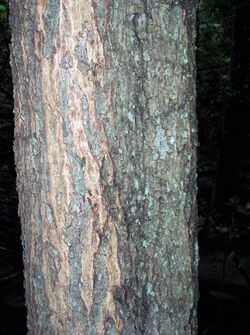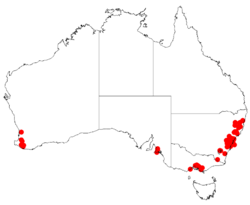Biology:Acacia elata
| Cedar wattle | |
|---|---|

| |

| |
| trunk of Acacia elata, Blue Mountains National Park, Australia | |
| Scientific classification | |
| Kingdom: | Plantae |
| Clade: | Tracheophytes |
| Clade: | Angiosperms |
| Clade: | Eudicots |
| Clade: | Rosids |
| Order: | Fabales |
| Family: | Fabaceae |
| Subfamily: | Caesalpinioideae |
| Clade: | Mimosoid clade |
| Genus: | Acacia |
| Species: | A. elata
|
| Binomial name | |
| Acacia elata | |

| |
| Occurrence data from AVH | |
| Synonyms | |
| |
Acacia elata, the cedar wattle or mountain cedar wattle, is a tree found in eastern Australia .[4]
Description
The tree can grow to a height of around 20 m (66 ft) when mature, with exceptional specimens reaching over 30 m (98 ft). It has deeply fissured bark with a dark brown to black colour at the base of the tree, and terete branchlets that are hairy when young. The dark green evergreen leaves typically have a length of 2.5 to 9 cm (0.98 to 3.54 in) with one prominent gland about halfway along. There are usually three to seven pairs of pinnae with a length of 7 to 23 cm (2.8 to 9.1 in) with 8 to 22 pairs of discolourous pinnules that have a lanceolate shape and a length of 2 to 5 cm (0.79 to 1.97 in).
The tree blooms between December and February, producing inflorescences in panicles or racemes with spherical flower-heads that have a diameter of 7 to 10 mm (0.28 to 0.39 in) and contain 30 to 55 pale yellow to cream-coloured flowers. The straight, flat seed pods that form after flowering have a length of 4 to 17.5 cm (1.6 to 6.9 in) and a width of 9 to 15 mm (0.35 to 0.59 in) that are firmly papery to leathery.[4]
Taxonomy
The species was first formally described in 1842 by the botanist George Bentham as part of William Jackson Hooker's work Notes on Mimoseae, with a synopsis of species, published in the London Journal of Botany. It was reclassified as Racosperma elatum by Leslie Pedley in 1987, but returned to genus Acacia in 2006. It is sometimes confused with Acacia terminalis.[5] The specific epithet refers to the plant's tall, tree-like habit.[4]
Distribution
The species is endemic to coastal areas of New South Wales. Its native range extends from the Budawang Range in the south as afar as the Bellinger River in the north.[4]
The habitat is near rainforest and wet sclerophyll forest in various situations. An attractive plant with delicate foliage, it is sometimes seen in cultivation. Its timber is attractive, close-grained, strong and hard, and is suitable for carpentry and turning.[citation needed]
It sometimes escapes from gardens and is considered as a weed in the wetter Warren and Jarrah Forest regions in the South West of Western Australia, where it grows in loamy lateritic soils.[6] It has also become naturalised in other parts of Australia, including Queensland and parts of Victoria.[4]
See also
References
- ↑ "Acacia elata". Australian Plant Name Index (APNI), IBIS database. Centre for Plant Biodiversity Research, Australian Government. https://biodiversity.org.au/nsl/services/rest/name/apni/62472.
- ↑ Bentham, G. (1842). Hooker, W.J.. ed. "Notes on Mimoseae, with a synopsis of species". London Journal of Botany 1: 383. https://biodiversitylibrary.org/page/10610863.
- ↑ "ILDIS LegumeWeb (version 10)". http://www.ildis.org/LegumeWeb/?version~10.01&LegumeWeb&tno~252&genus~Acacia&species~elata.
- ↑ 4.0 4.1 4.2 4.3 4.4 "Acacia elata". PlantNET - NSW Flora Online. Royal Botanic Gardens, Sydney. http://plantnet.rbgsyd.nsw.gov.au/cgi-bin/NSWfl.pl?page=nswfl&lvl=sp&name=Acacia~elata.
- ↑ "Acacia elata A.Cunn. ex Benth.". Atlas of Living Australia. Global Biodiversity Information Facility. https://bie.ala.org.au/species/http://id.biodiversity.org.au/node/apni/2910535#names.
- ↑ "Acacia elata". FloraBase. Western Australian Government Department of Parks and Wildlife. https://florabase.dpaw.wa.gov.au/browse/profile/18287.
Further reading
- Castro-Diez, P.; Langendoen, T.; Poorter, L.; Saldana-Lopez, A. (November 2011). "Predicting Acacia invasive success in South Africa on the basis of functional traits, native climatic niche and human use". Biodiversity and Conservation 20 (12): 2729–2743. doi:10.1007/s10531-011-0101-5.
- Donaldson, J.E.; Richardson, D.M.; Wilson, J.R.U. (September 2014). "The seed ecology of an ornamental wattle in South Africa — Why has Acacia elata not invaded a greater area?". South African Journal of Botany 94 (1): 40–45. doi:10.1016/j.sajb.2014.05.004.
- Korit, Alexander; Jermyn, Michael (March 3, 2005). "Acacia Proteinase Inhibitors Purification and Properties of the Trypsin Inhibitors from Acacia elutu Seed". European Journal of Biochemistry 115 (3): 551–557. doi:10.1111/j.1432-1033.1981.tb06238.x. PMID 7238519.
- Rehman, S.; Harris, P. J. C.; Bourne, W.F. (1998). "The effect of seed hardening on the salinity tolerance of Acacia seeds". Seed Science and Technology 26 (3): 743–754.
Wikidata ☰ Q2707367 entry
 |

